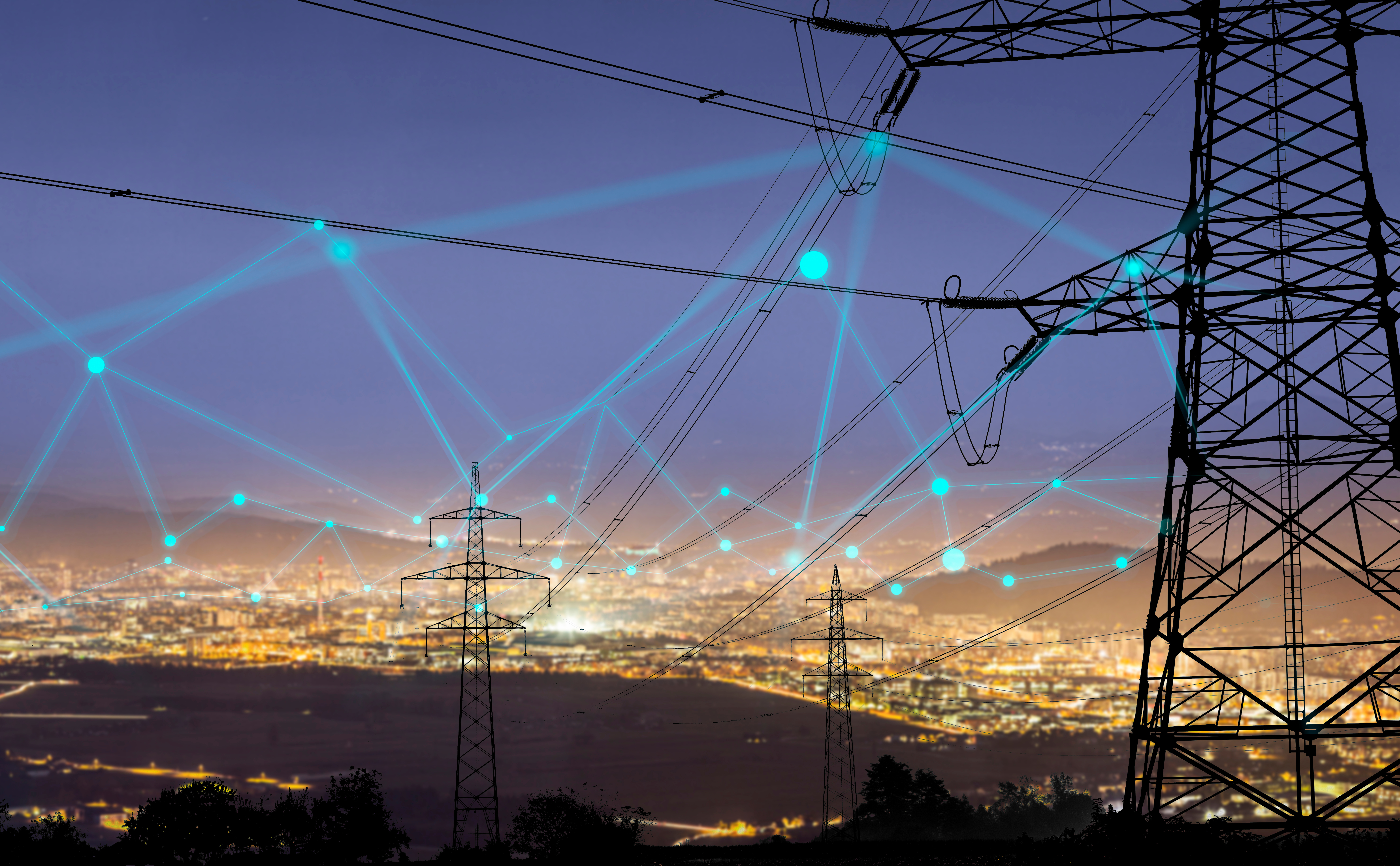Utility Risk Management
Proactively managing risk at scale
Utility companies are facing increasing pressure from environmental threats, regulatory demands, and aging infrastructure—all of which elevate operational risks. Logic20/20 partners with utilities to design and implement a comprehensive Utility Risk Framework that supports better decision making across emergency operations, capital investments, and maintenance planning.
Our data-driven approach unifies asset, environmental, and operational data into a scalable, AI-enabled platform that quantifies risk, prioritizes mitigation efforts, and improves situational awareness in real time. The result: a more resilient, transparent, and efficient power grid.

What is risk management in the utilities sector?
Utility risk management is the structured process of identifying, assessing, and mitigating threats that could disrupt operations, endanger public safety, or strain financial resources. These risks come from environmental hazards, regulatory pressures, infrastructure challenges, and financial constraints. By adopting a structured risk management approach, utilities can prevent disruptions, strengthen resilience, and meet evolving regulatory requirements.
The risks utilities face are diverse and evolving:
Environmental risks
Wildfires, extreme weather, and other climate change–related events
Operational risks
Equipment failures, vegetation overgrowth, and aging assets that increase the likelihood of outages
Regulatory risks
Financial risks
Budget constraints, cost recovery challenges, and investment decisions that impact long-term stability
Taking a holistic approach to risk management is essential for long-term success. Instead of addressing risks in isolation, utilities must integrate data-driven insights, cross-departmental collaboration, and proactive planning to develop a comprehensive strategy. A well-rounded approach considers not only immediate threats, but also long-term resilience, ensuring that risk mitigation efforts align with broader operational, regulatory, and financial goals.
Advanced risk modeling, predictive analytics, and modernized infrastructure allow utilities to transition from reactive to proactive risk management, improving resilience, resource allocation, and decision making.
Learn more about how utilities are addressing specific sources of risk:
Vegetation management
- Risk-based inspection schedules
- Enhanced tree clearance
- Strike-tree analysis
- Image data strategy and analysis—LiDAR, satellite, drone
Wildfire mitigation
- Cloud data platform and governance
- Wildfire operations and planning risk models
- Risk-spend efficiency (RSE) calculations and cost-benefit analysis
- Scenario simulation for “what if?” analyses
Asset management
- Risk modeling—ignition, failure, wildfire consequence
- Digital twins of the grid
- Risk-based inspections
- Computer vision for maintenance and inspection
- Asset health monitoring
Emergency preparedness
- Resiliency infrastructure and application modernization
- Interactive dashboards, including training mode and simulation capabilities
- Responder lifecycle management application
WEBINAR
Building a scalable wildfire mitigation program with a comprehensive approach to risk analytics
WHITE PAPER
Unified risk modeling for utility resilience
How Logic20/20 helps utilities mitigate risk
Logic20/20 provides customized risk management solutions that help utilities transition from reactive to predictive risk mitigation. With expertise in AI-driven analytics, cloud-based platforms, and regulatory compliance, Logic20/20 enables providers to:
Develop and implement risk modeling solutions
Enhance asset management, wildfire mitigation, and infrastructure resilience.
Enhance compliance tracking and reporting
Automated, data-driven systems align with regulatory requirements.
Optimize inspection and maintenance processes
Prioritize high-risk areas through predictive analytics
Modernize legacy risk management platforms
Integrate digital twins, cloud-based risk monitoring, and geospatial data analysis
By partnering with Logic20/20, utilities gain access to proven solutions that support a more resilient, risk-aware future:
Data foundations
- We create scalable platforms that integrate asset, vegetation, geospatial, weather, and risk data into a unified environment.
- We establish governance practices that ensure data quality, ownership, and update processes across operational and analytical systems.
AI models
- We train predictive models to estimate asset failure, vegetation risk, and wildfire likelihood using a wide range of data sources.
- Our risk modeling solutions support asset management, wildfire mitigation, and infrastructure resilience.
Operational tools
- We deliver interactive dashboards and scenario planning tools to guide decision making across planning, operations, and emergency response.
- Our tools support utility teams with visual analytics, automated workflows, and role-based insights that enhance situational awareness and efficiency.
Take a holistic approach to utility risk management
To mitigate risks effectively, utilities must adopt proactive, data-driven strategies that enhance resilience, improve decision making, and ensure regulatory compliance. By integrating advanced modeling techniques and data analytics, utilities can proactively manage risks and improve system resilience. (Click + for details on each strategy below.)
Advanced risk modeling
Artificial intelligence and machine learning are transforming how utilities predict, assess, and mitigate risks. These technologies analyze vast datasets—including climate patterns, historical failures, and real-time sensor inputs—to forecast asset degradation, wildfire threats, and system vulnerabilities. Predictive maintenance models extend asset life cycles and improve inspection efficiency by helping utilities prioritize high-risk areas.
Grid hardening and infrastructure upgrades
Strengthening infrastructure is key to reducing the impact of severe weather, equipment failures, and external threats. Utilities are increasingly investing in fire-resistant materials, advanced circuit breakers, underground power lines, and automated grid controls to improve reliability. Implementing self-healing grid technologies further enhances resilience by isolating faults and rerouting power automatically to minimize outages.
Data-driven risk mitigation
Utilities must go beyond historical trends and use real-time data analytics to identify emerging threats. By leveraging geospatial analysis, remote sensing, and predictive risk scoring, utilities can prioritize vegetation management, streamline maintenance scheduling, and refine emergency response strategies. This approach helps the utility allocate resources more efficiently, ensuring that high-risk areas receive attention before problems escalate.
Recommended steps for utility risk planning
As utilities look to scale their risk management strategies, adopting and integrating these technologies effectively is key. To ensure seamless implementation and maximum impact:
Pilot and validate AI-driven risk modeling
Start with controlled deployments to test model accuracy before full-scale rollout.
Enhance cross-departmental coordination
Ensure collaboration between operations, IT, and compliance teams to align risk management efforts.
Secure regulatory approval for new tools
Work closely with regulatory bodies to ensure AI-driven and cloud-based risk solutions meet compliance standards.
Develop a roadmap for long-term technology integration
Plan for scalable implementation, ensuring ongoing updates and improvements as technology evolves.
Insights

How AI is transforming utility emergency operations
How Gen AI is transforming utility emergency operations, as evidenced by a proof-of-concept AI decisioning assistant built by our team

Optimizing vegetation management: Advanced strategies
How AI, machine learning, and data integration are transforming vegetation management to enhance safety, efficiency, and regulatory compliance

AI desktop inspection: Transforming asset management
How AI-powered desktop inspections enhance asset management and predictive maintenance using drones and computer vision.

RSE modeling: Evaluating cost-benefit tradeoffs
Risk-Spend Efficiency (RSE) modeling helps utilities evaluate risk mitigation strategies by comparing potential risk reduction against investment costs. This approach enables providers to balance priorities such as grid hardening, vegetation management, and infrastructure upgrades while maximizing operational and financial efficiency. A structured RSE model supports long-term resilience by ensuring that resources are allocated where they have the greatest impact.
Harnessing technology for smarter risk management
Utilities are leveraging advanced technologies to enhance risk management, improve response times, and optimize resource allocation. AI-driven analytics enable real-time risk assessments, while digital twins simulate failure scenarios to refine mitigation strategies before implementation. Cloud-based platforms centralize risk data, supporting automated compliance tracking and disaster recovery. And a strong data governance framework ensures the accuracy and accessibility of risk-related information, allowing utilities to make informed, data-driven decisions.
Regulatory and compliance risks
Utilities must comply with complex, frequently updated mandates from federal and state agencies such as FERC and NERC. Staying compliant demands continuous investment in monitoring systems, reporting frameworks, and mitigation strategies—all while avoiding penalties for non-compliance. Regulatory uncertainty further complicates long-term planning, making it essential for utilities to stay agile and well prepared.
Climate change and related risks for power and utilities
Utilities must navigate an increasingly unpredictable operating environment, where extreme weather raises the risk for emergency situations and accelerated deterioration of infrastructure assets. Effectively managing these risks requires breaking down data silos, improving real-time monitoring, and coordinating across departments to implement scalable mitigation strategies.
Identifying climate risks
Recent data from NASA indicates that human activities have raised the atmosphere’s carbon dioxide content by 50 percent in less than 200 years, contributing significantly to global warming.
As climate change accelerates, utilities face increasing challenges from environmental hazards that can disrupt operations and threaten public safety. Identifying these climate risks is crucial for developing effective mitigation strategies and ensuring long-term resilience.
Key climate risks include:
- Extreme weather events: Increased frequency and severity of storms, heatwaves, and heavy precipitation can damage infrastructure and lead to service interruptions.
- Sea-level rise and flooding: Coastal utilities may experience infrastructure damage due to rising sea levels and increased flooding, impacting service reliability.
- Wildfires: Prolonged droughts and higher temperatures elevate wildfire risks, particularly in areas with extensive vegetation near power lines.
- Environmental regulatory and policy changes: Evolving environmental regulations require utilities to adapt operations to meet new compliance standards.
Climate risks and extreme weather
Extreme weather events are becoming less predictable and more severe, making traditional risk management approaches less effective. Utilities must adopt predictive climate modeling, scenario planning, and adaptive infrastructure strategies to mitigate risks effectively. By integrating real-time data analysis, historical weather tracking, and AI-driven analytics, utilities can improve response times, strengthen grid resilience, and reduce operational disruptions. Long-term climate projections help utilities prioritize investments that strengthen infrastructure against evolving risks.
Infrastructure investments and operational risks
Managing vast networks of aging infrastructure requires strategic decision making. Utilities must determine which assets to upgrade or replace first, optimize vegetation management programs, and deploy cost-effective solutions that enhance grid reliability without unnecessary spending. Without data-driven prioritization, utilities risk inefficient spending and increased system failures.

Case study
Data-driven risk mitigation in action
A major California utility partnered with Logic20/20 to enhance wildfire prevention using AI-driven risk mitigation. Traditionally, inspections were manual and inconsistent, delaying issue detection. To improve efficiency, the utility deployed an AI-powered inspection system that analyzed drone imagery to identify equipment anomalies with up to 80% accuracy. This data-driven approach accelerated maintenance decisions, strengthened safety, and improved compliance.
Frequently asked questions (FAQs)
What is an example of risk mitigation?
One example of risk mitigation is how a major California utility leveraged AI-driven inspections to reduce wildfire risk. Traditionally, the utility relied on manual, on-site inspections to identify equipment issues—an approach that was time-consuming and prone to inconsistencies. To improve efficiency and safety, the utility deployed an AI-powered inspection system that analyzed drone imagery to detect equipment anomalies with up to 80% accuracy.
This data-driven risk mitigation strategy allowed the utility to:
- Prioritize high-risk areas for maintenance, reducing wildfire threats
- Reduce manual inspections, lowering operational costs
- Enhance compliance tracking, ensuring alignment with regulatory requirements
By integrating AI and predictive analytics, the utility successfully transitioned from reactive to proactive risk management, improving both safety and operational efficiency.
What are some risk management strategies for utility companies?
Utility companies use proactive, data-driven strategies to mitigate risks and ensure long-term resilience. Key strategies include:
- Advanced risk modeling: AI and predictive analytics help utilities forecast wildfire threats, asset failures, and extreme weather impacts, allowing for targeted risk mitigation.
- Data-driven risk mitigation: Real-time data analytics, remote sensing, and predictive risk scoring enable utilities to prioritize vegetation management, streamline maintenance scheduling, and refine emergency response plans.
- Grid hardening and infrastructure upgrades: Investments in fire-resistant materials, underground power lines, and automated grid controls help utilities withstand severe weather and external threats.
- Risk-Spend Efficiency (RSE) modeling: By evaluating risk reduction versus cost, utilities can allocate resources efficiently, balancing investments in grid resilience, vegetation management, and asset modernization.
- Cloud-based risk platforms and digital twins: These tools centralize risk data, support real-time monitoring and compliance tracking, and allow utilities to simulate failure scenarios to refine mitigation strategies before implementation.
By integrating these strategies, utilities can transition from reactive to proactive risk management, improving safety, compliance, and operational efficiency.
Why is risk management important for utilities?
Effective risk management helps utilities protect infrastructure, maintain reliable service, and comply with regulatory requirements. Without a structured approach, utilities face increased operational costs, safety hazards, and regulatory penalties.
Key benefits of risk management include:
- Enhancing public safety: Prevents wildfires, power outages, and infrastructure failures that could endanger communities.
- Improving regulatory compliance: Ensures adherence to mandates from agencies like FERC and NERC, reducing the risk of fines and legal challenges.
- Optimizing resource allocation: Risk-Spend Efficiency (RSE) modeling helps utilities prioritize investments in grid hardening, vegetation management, and asset upgrades.
- Reducing financial risk: Identifies and mitigates costly disruptions, preventing unexpected repair expenses and revenue losses.
Increasing operational resilience: Enables utilities to anticipate and respond to extreme weather, cyber threats, and equipment failures before they escalate.
By implementing data-driven risk management strategies, utilities can ensure long-term reliability, regulatory alignment, and financial stability in an increasingly complex environment.
What are some utility risk mitigation tools?
Utility companies use a combination of advanced technologies and analytical tools to identify, assess, and mitigate risks effectively. Key risk mitigation tools include:
- AI-driven risk modeling: Uses machine learning to predict asset failures, wildfire risks, and extreme weather impacts, enabling proactive decision-making.
- Digital twins: Creates real-time simulations of grid infrastructure and failure scenarios, allowing utilities to test and refine mitigation strategies before implementation.
- Cloud-based risk platforms: Centralizes risk data, compliance tracking, and emergency response coordination, improving decision-making and disaster recovery.
- Geospatial and remote sensing tools: Use satellite imagery, LiDAR, and drones to monitor vegetation growth and infrastructure vulnerabilities.
- Predictive maintenance systems: Leverage sensor data and analytics to detect early signs of equipment degradation, reducing the risk of unexpected failures.
- Risk-Spend Efficiency (RSE) modeling: Helps utilities quantify risk reduction vs. cost, ensuring that mitigation investments maximize safety and financial sustainability.
By integrating these data-driven risk mitigation tools, utilities can enhance safety, improve resilience, and optimize operational efficiency.
What are the key steps in utility risk mitigation?
Effective utility risk mitigation follows a structured approach to identify, assess, and address potential threats. Key steps include:
- Identifying risks: Use historical data, real-time monitoring, and predictive analytics to assess vulnerabilities, such as extreme weather, asset failures, and vegetation overgrowth.
- Evaluating impact: Conduct risk assessments and scenario modeling to quantify potential financial, operational, and regulatory consequences.
- Developing mitigation strategies: Implement AI-driven risk modeling, grid hardening, vegetation management, and asset upgrades to reduce risks effectively.
- Prioritizing risk reduction efforts: Use Risk-Spend Efficiency (RSE) modeling to allocate resources where they provide the greatest impact at the lowest cost.
- Monitoring and adjusting strategies: Continuously track risk trends, compliance changes, and mitigation effectiveness using cloud-based risk platforms and digital twins.
By following these steps, utilities can transition from reactive to proactive risk management, ensuring long-term reliability, compliance, and financial stability.
What are your risk management challenges? Let’s talk through the solutions.

